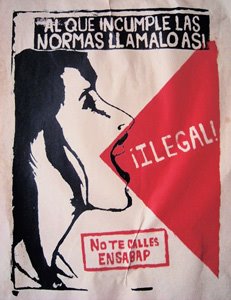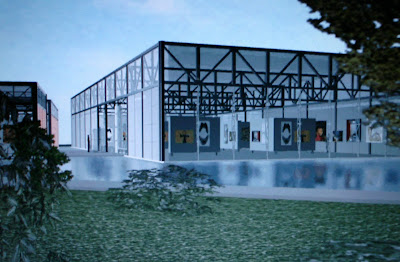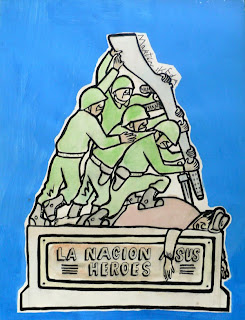domingo, mayo 24, 2009
IILA - Biennale di Venecia - Irma Arestizábal.
Me han participado vía correo electrónico que Irma Arestizábal (quien desde la dirección del Instituto Italo Latino Americano de Roma, ha venido organizando y curando la representación de varios países latinoamericanos dentro de la Bienal de Venecia) ha fallecido hace una semana. Ella había estado internada durante el último mes. Su proyecto de exposición para la 53 bienal de Venecia queda en manos de las personas que trabajan en el IILA. Desde este blog lamentamos enormemente esta súbita noticia. Adjunto aquí la información sobre el pabellón organizado por el IILA, enviada por E-flux a fines de abril.
Latin American Pavilion - IILA
53rd International Art Exhibition
La Biennale di Venezia
Mundus Novus/New Worlds: Contemporary Art of Latin America
Bolivia, Colombia, Costa Rica, Cuba, Ecuador, El Salvador, Guatemala, Honduras, Peru, Dominican Republic.
June 7 - November 22, 2009
Artigliere dell'Arsenale - 30121 Venice
http://www.iila.org
Commissioner: Patricia Rivadeneira, Cultural Secretary of the IILA
Assistant Commissioner: Alessandra Bonanni
Curator: Irma Arestizábal
Opening: June 5, 6:30 p.m.
http://www.iila.org
http://www.labiennale.org
Within the general theme selected for the 2009 edition of the 53rd International Art Exhibition, Fare Mondi/Making Worlds, the Pavilion of the Istituto Italo-Latinoamericano (IILA) representing Latin America will bear the name Mundus Novus - Contemporary Art of Latin America.
The pavilion will occupy 700 square meters in Artigliere dell'Arsenale, one of the most noble exhibition spaces in Venice, along with I Giardini (The Garden).
Following the lead set by the Biennale Art Director, Daniel Birbaum, the Latin American Pavilion, curated by Irma Arestizábal, will not be divided into sections but rather is a unique exhibition intertwining different themes in an organic unity, where the artworks will interact and dialogue among themselves and the space itself.
Artists from Bolivia, Colombia, Costa Rica, Cuba, Ecuador, El Salvador, Guatemala, Honduras, Peru and the Dominican Republic will make up the Latin American Pavilion in 2009.
Alberto Baraya (Colombia) has worked on Herbarium of Artificial Plants for a long time; it is a work in progress which reformulates the scientific journeys of the XVIII and XIX centuries. At the 53rd Venice Biennale, Baraya will create an Expedition to Venice, gathering flowers produced at the Murano glass ovens or the ones that are sold in the tourist outlets of the City of Venice.
In Olimpo Fernando Falconí (Ecuador) explores the image of the Chimborazo volcano, a geographic and historic Latin American landmark. A video portrays the melting of the volcano´s snow cap.
The New World Gods are represented by Darío Escobar (Guatemala) in his Kukulcan Installation. Dominated by the tail of a red Quetzalcoatl, the mythical feathered serpent made out bicycle tires, which follows the artist´s longtime research project related to the re-contextualization of the object as a piece of art.
Paper Moon by Paul Ramírez Jonas (Honduras), that makes us think about how its crescent shape is perceived in various ways in the Southern Hemisphere, talks to us about recovering the meaning of words when he says: I Create as I Talk. His ABRACADABRA piece reconstructs the image conceptually.
The Cloud by Ramses Larzábal (Cuba) reinforces the constructivist vocation of Latin American art.
Such a vocation also guides the production of Luis Roldán (Colombia) who evokes a lyrical and existential dimension of urban life in his work that is made out of little fragments.
A different vision of a city comes from Carlos Garaicoa (Cuba), who plays with architectural renderings as if he was the biographer of a place made out of wax, light, bricks and paper.
A strange world populated by rare specimens and diverse ethnic Mutants is how Raquel Paiewonsky (Dominican Republic) fuses elements of urban life, stereotypes of all kind, nature, spirituality and instinct.
The color of plants, birds, and the sky create a palette of diverse hues and patterns. That is what one experiences with the work of Federico Herrero (Costa Rica) who, in a mélange of gesture and color, paints places where, according to his sentiment, color is essential.
Color and patterns that evoke Latin America´s cultural syncretism are also key in the Inca and Aymara textile installation assembled by Gastón Ugalde (Bolivia), creating a spectacular setting of design and texture.
A new vision of space is brought to our attention in the tromp l´oeil effect created by photographer Nils Nova (El Salvador), dissolving the limits between reality and fiction. In his work, Nova defies the classic perspective creating an image of the space dedicated to the Latin American Pavilion, and projecting it into infinity.
It is also the space of the Latin American Pavilion itself and the artworks comprising the Latin American representation at the Biennale that is reflected in the painting of Sandra Gamarra (Peru). Her canvas summarizes the New Worlds presented by the Region at the 53rd Biennale di Venezia.
Inauguration:
Biennale: June 4, 5, and 6, 2009.
IILA Pavilion Mundus Novus - Contemporary Art of Latin America: June 5, at 6:30 p.m.
Catalogue
An illustrated catalogue that will also include other works related to the exhibition will be available.
Sponsor:
Inter-American Development Bank Cultural Center, Washington, D.C.
MACIA - Museo de Arte Contemporáneo Italiano en América
MALI - Museo de Arte de Lima - Perú
Fondazione Logudoro – Italia
Fundación Punta del Este
Museo de Arte de la República Dominicana – Santo Domingo
PINTA - the Modern and Contemporary Latin American Art Fair, New York, London
Cultural Secretariat: +39 06 68492.224 – 246; e-mail: s.culturale@iila.org
Press Office: Tel. +39 06 68492.209; e-mail: stampa@iila.org
Istituto Italo-Latino Americano - Palazzo Santacroce - Piazza Benedetto Cairoli, 3 - 00186 Roma - Italia. Tel. +39 06 68492.1 - Fax +39 06 6872834 - http://www.iila.org
Latin American Pavilion - IILA
53rd International Art Exhibition
La Biennale di Venezia
Mundus Novus/New Worlds: Contemporary Art of Latin America
Bolivia, Colombia, Costa Rica, Cuba, Ecuador, El Salvador, Guatemala, Honduras, Peru, Dominican Republic.
June 7 - November 22, 2009
Artigliere dell'Arsenale - 30121 Venice
http://www.iila.org
Commissioner: Patricia Rivadeneira, Cultural Secretary of the IILA
Assistant Commissioner: Alessandra Bonanni
Curator: Irma Arestizábal
Opening: June 5, 6:30 p.m.
http://www.iila.org
http://www.labiennale.org
Within the general theme selected for the 2009 edition of the 53rd International Art Exhibition, Fare Mondi/Making Worlds, the Pavilion of the Istituto Italo-Latinoamericano (IILA) representing Latin America will bear the name Mundus Novus - Contemporary Art of Latin America.
The pavilion will occupy 700 square meters in Artigliere dell'Arsenale, one of the most noble exhibition spaces in Venice, along with I Giardini (The Garden).
Following the lead set by the Biennale Art Director, Daniel Birbaum, the Latin American Pavilion, curated by Irma Arestizábal, will not be divided into sections but rather is a unique exhibition intertwining different themes in an organic unity, where the artworks will interact and dialogue among themselves and the space itself.
Artists from Bolivia, Colombia, Costa Rica, Cuba, Ecuador, El Salvador, Guatemala, Honduras, Peru and the Dominican Republic will make up the Latin American Pavilion in 2009.
Alberto Baraya (Colombia) has worked on Herbarium of Artificial Plants for a long time; it is a work in progress which reformulates the scientific journeys of the XVIII and XIX centuries. At the 53rd Venice Biennale, Baraya will create an Expedition to Venice, gathering flowers produced at the Murano glass ovens or the ones that are sold in the tourist outlets of the City of Venice.
In Olimpo Fernando Falconí (Ecuador) explores the image of the Chimborazo volcano, a geographic and historic Latin American landmark. A video portrays the melting of the volcano´s snow cap.
The New World Gods are represented by Darío Escobar (Guatemala) in his Kukulcan Installation. Dominated by the tail of a red Quetzalcoatl, the mythical feathered serpent made out bicycle tires, which follows the artist´s longtime research project related to the re-contextualization of the object as a piece of art.
Paper Moon by Paul Ramírez Jonas (Honduras), that makes us think about how its crescent shape is perceived in various ways in the Southern Hemisphere, talks to us about recovering the meaning of words when he says: I Create as I Talk. His ABRACADABRA piece reconstructs the image conceptually.
The Cloud by Ramses Larzábal (Cuba) reinforces the constructivist vocation of Latin American art.
Such a vocation also guides the production of Luis Roldán (Colombia) who evokes a lyrical and existential dimension of urban life in his work that is made out of little fragments.
A different vision of a city comes from Carlos Garaicoa (Cuba), who plays with architectural renderings as if he was the biographer of a place made out of wax, light, bricks and paper.
A strange world populated by rare specimens and diverse ethnic Mutants is how Raquel Paiewonsky (Dominican Republic) fuses elements of urban life, stereotypes of all kind, nature, spirituality and instinct.
The color of plants, birds, and the sky create a palette of diverse hues and patterns. That is what one experiences with the work of Federico Herrero (Costa Rica) who, in a mélange of gesture and color, paints places where, according to his sentiment, color is essential.
Color and patterns that evoke Latin America´s cultural syncretism are also key in the Inca and Aymara textile installation assembled by Gastón Ugalde (Bolivia), creating a spectacular setting of design and texture.
A new vision of space is brought to our attention in the tromp l´oeil effect created by photographer Nils Nova (El Salvador), dissolving the limits between reality and fiction. In his work, Nova defies the classic perspective creating an image of the space dedicated to the Latin American Pavilion, and projecting it into infinity.
It is also the space of the Latin American Pavilion itself and the artworks comprising the Latin American representation at the Biennale that is reflected in the painting of Sandra Gamarra (Peru). Her canvas summarizes the New Worlds presented by the Region at the 53rd Biennale di Venezia.
Inauguration:
Biennale: June 4, 5, and 6, 2009.
IILA Pavilion Mundus Novus - Contemporary Art of Latin America: June 5, at 6:30 p.m.
Catalogue
An illustrated catalogue that will also include other works related to the exhibition will be available.
Sponsor:
Inter-American Development Bank Cultural Center, Washington, D.C.
MACIA - Museo de Arte Contemporáneo Italiano en América
MALI - Museo de Arte de Lima - Perú
Fondazione Logudoro – Italia
Fundación Punta del Este
Museo de Arte de la República Dominicana – Santo Domingo
PINTA - the Modern and Contemporary Latin American Art Fair, New York, London
Cultural Secretariat: +39 06 68492.224 – 246; e-mail: s.culturale@iila.org
Press Office: Tel. +39 06 68492.209; e-mail: stampa@iila.org
Istituto Italo-Latino Americano - Palazzo Santacroce - Piazza Benedetto Cairoli, 3 - 00186 Roma - Italia. Tel. +39 06 68492.1 - Fax +39 06 6872834 - http://www.iila.org
Suscribirse a:
Comentarios de la entrada (Atom)
![[flyer.jpg]](http://4.bp.blogspot.com/_pvbHa013fFM/SdVn5xJxYVI/AAAAAAAAB6k/uCATKnGK-0o/s400/89jpg.jpg)
![[flyer.jpg]](http://3.bp.blogspot.com/_pvbHa013fFM/SZYbEhrckFI/AAAAAAAAB3Q/3AvlpBq-VTY/s1600/flyer.jpg)






No hay comentarios.:
Publicar un comentario